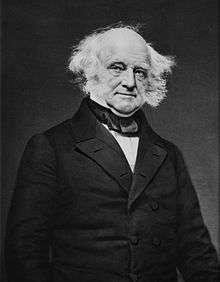Felix Grundy
| Felix Grundy | |
|---|---|
 | |
| 13th United States Attorney General | |
|
In office July 5, 1838 – December 14, 1839 | |
| President | Martin Van Buren |
| Preceded by | Benjamin F. Butler |
| Succeeded by | Henry D. Gilpin |
| United States Senator from Tennessee | |
|
In office December 14, 1839 – December 19, 1840 | |
| Preceded by | Ephraim H. Foster |
| Succeeded by | Alfred O. P. Nicholson |
|
In office October 19, 1829 – July 4, 1838 | |
| Preceded by | John Eaton |
| Succeeded by | Ephraim H. Foster |
| Member of the U.S. House of Representatives from Tennessee's 5th district | |
|
In office March 4, 1813 – July 19, 1814 | |
| Preceded by | Constituency established |
| Succeeded by | Newton Cannon |
| Member of the U.S. House of Representatives from Tennessee's 3rd district | |
|
In office March 4, 1811 – March 3, 1813 | |
| Preceded by | James Randolph |
| Succeeded by | Augustus Pettibone |
| Chief Justice of the Kentucky Court of Appeals | |
|
In office 1807–1808 | |
| Preceded by | Thomas Todd |
| Succeeded by | Ninian Edwards |
| Personal details | |
| Born |
September 11, 1777 Berkley County, Virginia, U.S. (now West Virginia) |
| Died |
December 19, 1840 (aged 63) Nashville, Tennessee, U.S. |
| Political party |
Democratic-Republican (Before 1825) Democratic (1825–1840) |
| Spouse(s) | Ann Phillips Rodgers |
| Signature |
|
Felix Grundy (September 11, 1777 – December 19, 1840) was a congressman and senator from Tennessee and served as the 13th Attorney General of the United States.
Biography
Early life
Born in Berkeley County, Virginia (now Berkeley County, West Virginia), Grundy moved to Brownsville, Pennsylvania, and then Kentucky with his parents. He was educated at home and at the Bardstown Academy in Bardstown, Kentucky.[1] He then read law, was admitted to the Kentucky bar, and commenced practice in Springfield, Kentucky, in 1799.[1]
Career
In 1799, he was chosen to represent Washington County at the convention that drafted the second Kentucky Constitution.[1] From 1800 to 1802, he represented Washington County in the Kentucky House of Representatives.[1] He then moved to Nelson County, which he represented in the Kentucky House from 1804 to 1806.[1] On December 10, 1806, he was commissioned an associate justice of the Kentucky Court of Appeals.[1] He was elevated to Chief Justice of the court on April 11, 1807.[1] Later that year, he resigned and moved to Nashville, Tennessee, where he again took up the practice of law.[1]
He was elected as a Democratic-Republican to the 12th and 13th Congresses and served from March 4, 1811, until his resignation in July 1814.[2]
He then became a member of the Tennessee House of Representatives from 1819 to 1825, and in 1820 was commissioner to settle the boundary line (state line) between Tennessee and Kentucky. He was elected as a Jacksonian in 1829 to the United States Senate to fill the vacancy in the term ending March 4, 1833, caused by the resignation of John H. Eaton to join the Cabinet of President Andrew Jackson; reelected in 1832 and served from October 19, 1829, to July 4, 1838, when he resigned to accept a Cabinet position. During this time he served as chairman of the U.S. Senate Committee on Post Offices and Post Roads (21st through 24th Congresses), U.S. Senate Committee on the Judiciary (24th and 25th Congresses).
He entered the Cabinet when he was appointed Attorney General of the United States by President Martin Van Buren in July 1838. He resigned the post in December 1839, having been elected as a Democrat to the United States Senate on November 19, 1839, to fill the vacancy in the term commencing March 4, 1839, caused by the resignation of Ephraim Foster; the question of his eligibility to election as Senator while holding the office of Attorney General of the United States having been raised, he resigned on December 14, 1839, and was reelected to the Senate the same day, serving from December 14, 1839, until his death in Nashville, a little over a year later. During this stint in the upper house of the U.S. Congress he served as chairman of the U.S. Senate Committee on Revolutionary Claims in the 26th Congress.
Death
He is interred in the Mount Olivet Cemetery in Nashville, Tennessee. There are four Grundy Counties, including the one in Illinois, named in his honor.[3] Grundy County and its county seat, Grundy Center, Iowa, are both also named in his honor. Grundy Center's annual festival "Felix Grundy Days", are held each July. There is also a Town of Grundy, Virginia named for him in Buchanan County, Virginia.In Tennessee there is a county named Grundy County, Tennessee
Legacy
He was a mentor to future President James K. Polk. Polk purchased Grundy's home called "Grundy Place" and changed the name to "Polk Place". He lived and died there after his presidency. It was demolished in 1901.
Further reading
- Baylor, Orville W. (April 1942). "Felix Grundy, 1777-1840". Filson Club History Quarterly. 16 (2). Retrieved December 6, 2011.
- Heller III, J. Roderick (2010). Democracy's Lawyer: Felix Grundy of the Old Southwest. Baton Rouge: LSU Press. ISBN 978-0-8071-3588-4.
See also
Notes
Bibliography
- Biographical Cyclopedia of the Commonwealth of Kentucky. Chicago, Illinois: J.M. Gresham Company. 1896.
External links
| Wikimedia Commons has media related to Felix Grundy. |
- United States Congress. "Felix Grundy (id: G000509)". Biographical Directory of the United States Congress.
- Allen, William B. (1872). A History of Kentucky: Embracing Gleanings, Reminiscences, Antiquities, Natural Curiosities, Statistics, and Biographical Sketches of Pioneers, Soldiers, Jurists, Lawyers, Statesmen, Divines, Mechanics, Farmers, Merchants, and Other Leading Men, of All Occupations and Pursuits. Bradley & Gilbert. pp. 351&ndash, 352. Retrieved November 10, 2008.
| U.S. House of Representatives | ||
|---|---|---|
| Preceded by James H. Randolph |
Member of the U.S. House of Representatives from Tennessee's 3rd congressional district 1811-1813 |
Succeeded by Augustus H. Pettibone |
| Preceded by District created |
Member of the U.S. House of Representatives from Tennessee's 5th congressional district 1813-1814 |
Succeeded by Newton Cannon |
| U.S. Senate | ||
| Preceded by John Eaton |
U.S. Senator (Class 1) from Tennessee 1829–1838 Served alongside: Hugh L. White |
Succeeded by Ephraim H. Foster |
| Preceded by Ephraim H. Foster |
U.S. Senator (Class 1) from Tennessee 1839–1840 Served alongside: Hugh L. White, Alexander O. Anderson |
Succeeded by Alfred O. P. Nicholson |
| Political offices | ||
| Preceded by John M. Clayton |
Chairman of the Senate Judiciary Committee 1836–1838 |
Succeeded by Garret D. Wall |
| Legal offices | ||
| Preceded by Benjamin F. Butler |
U.S. Attorney General Served under: Martin Van Buren 1838–1840 |
Succeeded by Henry D. Gilpin |


